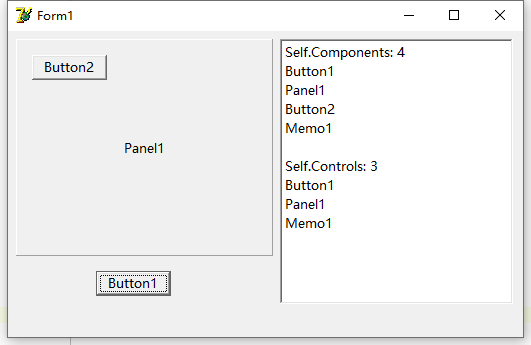Delphi Controls (控件)和Components (组件)的区别
Delphi Controls (控件)和Components (组件)的区别
Components //列出该组件拥有的所有组件。
1 | property Components[Index: Integer]: TComponent; |
使用组件访问此组件拥有的任何组件,例如窗体拥有的组件。当按编号而不是名称引用所拥有的组件时,Components属性最有用。它也在内部用于迭代处理所有拥有的组件。
索引范围从0到ComponentIndex减1。
Controls //列出所有子控件。 控件是所有子控件的数组
1 | property Controls[Index: Integer]: TControl; |
控件是所有子控件的数组。这些都是将此控件列为其父属性的控件。Controls属性便于通过数字而不是名称引用控件的子级。例如,控件可用于迭代所有子控件。
不要混淆Controls属性和Components属性。Controls属性列出作为控件子窗口的所有控件,而Components属性列出它拥有的所有组件。窗体拥有放置在其上的所有组件,因此,即使它们是窗体上控件的子窗口,它们也会出现在窗体的组件属性列表中。
控件是只读属性。
一个容器控件如果被其他控件指定为属主(Owner) 那么 Components 则+1;
一个容器控件如果被其他控件指定为 Parent, 那么 Controls 则+1;
可以简单理解成:组件(Components)包含控件(Controls)
示例:


1 2 3 4 5 6 7 8 9 10 11 12 13 14 15 16 17 18 19 20 21 22 23 24 25 26 27 28 29 30 31 32 33 34 35 36 37 38 39 40 41 42 43 44 45 46 | //滔Roy 2021.06.03unit Unit1;interfaceuses Windows, Messages, SysUtils, Variants, Classes, Graphics, Controls, Forms, Dialogs, StdCtrls, ExtCtrls;type TForm1 = class(TForm) Button1: TButton; Panel1: TPanel; Memo1: TMemo; Button2: TButton; procedure Button1Click(Sender: TObject); private { Private declarations } public { Public declarations } end;var Form1: TForm1;implementation{$R *.dfm}procedure TForm1.Button1Click(Sender: TObject);var i: Integer;begin Memo1.Clear; Memo1.Lines.Add('Self.Components: '+ IntToStr(Self.ComponentCount)); for i := 0 to Self.ComponentCount - 1 do Memo1.Lines.Add(Components[i].Name); Memo1.Lines.Add(''); Memo1.Lines.Add('Self.Controls: '+ IntToStr(Self.ControlCount)); for i := 0 to Self.ControlCount - 1 do Memo1.Lines.Add(Controls[i].Name);end;end. |
创建时间:2021.06.03 更新时间:





【推荐】国内首个AI IDE,深度理解中文开发场景,立即下载体验Trae
【推荐】编程新体验,更懂你的AI,立即体验豆包MarsCode编程助手
【推荐】抖音旗下AI助手豆包,你的智能百科全书,全免费不限次数
【推荐】轻量又高性能的 SSH 工具 IShell:AI 加持,快人一步
· Linux系列:如何用heaptrack跟踪.NET程序的非托管内存泄露
· 开发者必知的日志记录最佳实践
· SQL Server 2025 AI相关能力初探
· Linux系列:如何用 C#调用 C方法造成内存泄露
· AI与.NET技术实操系列(二):开始使用ML.NET
· 【自荐】一款简洁、开源的在线白板工具 Drawnix
· 没有Manus邀请码?试试免邀请码的MGX或者开源的OpenManus吧
· 园子的第一款AI主题卫衣上架——"HELLO! HOW CAN I ASSIST YOU TODAY
· 无需6万激活码!GitHub神秘组织3小时极速复刻Manus,手把手教你使用OpenManus搭建本
· C#/.NET/.NET Core优秀项目和框架2025年2月简报